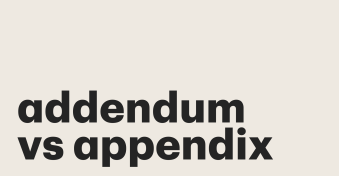Wondering about the difference between an addendum vs exhibit?
It’s easy to get the two confused, but it’s essential to understand how each of these documents can help you manage contracts.
We’ll explore this and more in this article.
Key takeaways
- An addendum is a way of updating the terms of a contract.
- An exhibit supplements a contract by providing additional information and context.
- Both addendums and exhibits are essential and serve various purposes across various industries.
- PandaDoc can give you the tools you need to create comprehensive contracts with ease.
What does an addendum mean?
An addendum to a contract is essentially an update to an original agreement.
They’re typically included alongside a contract as an extra document.
The right contract software can make things much easier by providing access to addendum templates. These help you to easily create the document you need.
Once a contract is signed, it can be challenging to make changes.
If elements of the contract no longer apply, however, there’s a real risk that the document could be rendered ‘void’.
An addendum enables parties to change the terms without damaging the agreement.
They can serve lots of different purposes, including:
- Increasing the duration of a contract
- Altering the terms of payment
- Updating the methods of payment
- Nullifying a specific section of the contract
- Providing additional clauses
- Adding terms or definitions omitted from the original contract
Addendums aren’t only used to make changes to a contract.
Sometimes, they’re a handy way of clarifying any uncertainty within the agreement.
They might include diagrams, graphs, or other visual aids to help readers understand these better.
Generally, parties need to agree to any modifications by signing the addendum.
Depending on the nature of the update to be covered by it, signatures may also need to be witnessed.
What does a contract exhibit mean?
Much like an addendum, a contract exhibit takes the form of extra documentation included alongside the contract.
Exhibits provide additional context for agreements.
Sometimes, a contract will reference a separate document.
The contract will thus inform the reader of the document they need to refer to, e.g., exhibits A, B, etc.
Contract exhibits can be split into two groups — boilerplate documents and standalone agreements.
Let’s look at each of these in a little more detail.
Boilerplate documents
These are exhibits that help establish the rights of each party.
This includes how disputes will be resolved, where lawsuits will take place, and the laws that govern any disagreements.
Standalone agreements
These exhibits are entirely negotiable and usually used in scenarios such as the sale of a business.
They might include measures such as stakeholder agreements or estoppels.
When to use exhibit vs addendum
Both exhibits and addendums serve separate and distinct purposes.
Here’s how these two documents are used within various industries.
Real estate
How an addendum is used in real estate
An addendum can be used for various purposes in real estate. Some of these are listed below.
A landlord might use a lease addendum alongside a rental agreement, e.g., to add detail to restrictions relating to keeping animals on the property.
This supplement can be as detailed as necessary, including, for example, a list of animals that are allowed (e.g., cats, dogs, rabbits) and those that are excluded (e.g., snakes, venomous spiders, etc).
Alternatively, an addendum might be used to clarify rights of public access across land covered by the contract.
If, for example, legal public access across part of the land was omitted from the original document, this could be recognized in an addendum.
Additionally, on the sale of a property, an addendum could be used to add furniture or fixtures and fittings within the property that are included in the sale but not listed in the original contract.
The addendum might include an agreed price for these additions.
An addendum could also be included to allow a tenant to sub-let a property where this was either unclear or not allowed in the original contract.
This addendum might include details and conditions related to the sublet.
How a contract exhibit is used in real estate
Examples of an exhibit being used in real estate, on the other hand, include:
- Maps showing the land covered by a contract, with relevant details such as building boundaries, waterways, roads, and pathways.
- Architectural drawings detailing the property concerned. These might cover both the external aspects as well as individual room plans.
- Samples of documents that will be signed later in the process. This could relate to various docs, such as final contract exchange or ongoing maintenance arrangements.
- Government searches of the land relating to previous use, e.g., mining activity.
- Flood and other risk assessments.
Legal briefs
How an addendum is used in legal briefs
A legal brief is a document submitted to a court outlining the case a legal team wishes to present. Some addendum examples in this context include:
- Providing additional evidence or statements that emerged later in the process. This could include information about a new witness statement, new evidence to support an alibi (such as proof of whereabouts), or anything relevant.
- Adding additional information to the original brief where this was unclear. This could be a fuller explanation of technical details or further information that should have been included.
- Clarifying a point of law referenced in the original brief (such as a previous case where a precedent was set).
How a contract exhibit is used in legal briefs
Exhibits can also include many items relevant to the case, such as:
- Medical reports relating to injuries sustained, e.g., in a compensation claim following a motor accident.
- Phone records that might, for example, demonstrate regular contact between two parties.
- Photographic evidence that relates to a person’s location at the time of an incident.
- Technical documentation relating to the case.
- DNA results relating to participants and from a crime scene.
Corporate contracts
How an addendum is used in corporate contracts
Finally, a corporate contract is an agreement between two or more corporate bodies.
It specifies the obligations and responsibilities of each party.
The document describes the details of the proposed relationship and includes relevant information that can be used to assess each party’s delivery of responsibilities.
Addendums can be used for a variety of purposes in corporate contracts.
You might write an addendum to a contract for the following reasons.
- A contract relating to a purchase agreement between corporate bodies might include an addendum describing updated payment terms and conditions agreed upon by both parties.
- A contract for the provision of services could include minimum service levels and details of penalties incurred.
- An addendum might detail any exceptions and circumstances where minimum service levels will be waived and additional details about penalties.
- An addendum could adjust a minimum order level between parties agreed in a contract.
- Where parties are undertaking a joint venture, the contract might stipulate governance arrangements. An addendum could be used to update or expand upon these where necessary.
How a contract exhibit is used in corporate contracts
Exhibits can also be used for various purposes in business agreements. Some examples are:
- A list of minimum service levels and service targets
- Lists of governance procedures and descriptions of board members
- A sample invoice or other similar documents to show the required format
- A list of authorized signatories who can approve specific requests
- A schedule of service reviews and customer satisfaction surveys
Generate contracts quickly with PandaDoc
Hopefully, you can now see that there are clear differences between an addendum versus an exhibit. However, both play essential roles in the lifecycle of a contract.
Each of these documents requires care and attention.
They should be clear and comprehensive, as mistakes could lead to an incomplete or inaccurate agreement.
Contracts are intricate documents and easy to get wrong.
Factors to take into account include:
- The objectives of each party
- The responsibilities of each party
- The kind of relationship you’re trying to establish
- Legal obligations and constraints
- Ensuring your document is legally compliant and binding
- Supporting documents that are required to ensure a full understanding of the intended process
Each of these factors is essential, and creating contracts from scratch can be challenging and time-consuming.
That’s where PandaDoc comes in.
Our contract management software provides tools to create, collaborate, manage, and even e-sign contracts.
This includes access to a library of customizable and legally binding templates, enabling you to quickly design the document you need.
So, why not try it for yourself? Sign up for a 14-day trial today or request a demo by clicking this link.
Disclaimer
PandaDoc is not a law firm, or a substitute for an attorney or law firm. This page is not intended to and does not provide legal advice. Should you have legal questions on the validity of e-signatures or digital signatures and the enforceability thereof, please consult with an attorney or law firm. Use of PandaDoc services are governed by our Terms of Use and Privacy Policy.


